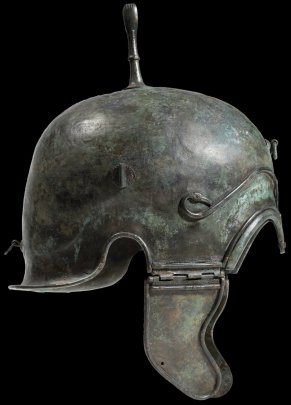A map of the 19th century, of Roman Hispania, that is the modern states of Spain and Portugal.
A 19th century map of Roman Hispania
23/09/2021
Uncategorized Hispania, Iberian Peninsula, Lusitania, Portugal, Roman, Roman army, Roman Empire, Roman legion, Roman warfare, Romans, Rome, Spain Leave a comment
The Reconquista in the Iberian peninsula, part I
27/07/2020
Uncategorized Iberian Peninsula, Portugal, Reconquista, Spain Leave a comment
The first two maps on the Reconquista in medieval Spain and Portugal, that is a series of campaigns by Christian states to recapture territory from the Muslims (Moors), who had occupied most of the Iberian Peninsula in the early 8th century.
Remains of weapons, sandals and coins shed new light on Roman conquest of Northwest Iberia
13/05/2019
Uncategorized Asturia, Augustus, Cantabria, Cantabrian-Asturian Wars, Galicia, Iberia, Portugal, Roman, Roman army, Roman Empire, Roman warfare, Romans, Rome, Spain, Spanish Leave a comment
Republication from www.exeter.ac.uk (University of Exeter)
.
Reenactment in Spain – Image Credit : Franciscojh -Wikimedia commons
.
Newly discovered remains of weapons, hobnails from sandals and coins will help experts piece together the untold story of how the Romans won control of Galicia and Northern Portugal from local tribes for the first time.
Archaeologists have found the oldest evidence yet of the presence of legions in Galicia in the Penedo dos Lobos Roman camp (Manzaneda, Ourense, Galicia). This significant discovery will help to redefine the history of the period.
Until now historians had found few clues about the actions of Roman soldiers in these regions. The findings show some, smaller groups, of legionnaires were probably sent on scouting missions in the area to investigate the landscape, rather than to fight, suggesting the region was already under Roman control by the end of 1st century BC, when the bronze coins found were made.
Μία περίπτωση ελληνικής επιρροής στο αρχαίο ιβηρικό οπλοστάσιο: κελτιβηρικό κράνος χαλκιδικού τύπου
26/06/2017
Uncategorized Ancient warfare, Celtiberians, helmet, Hispania, Iberians, Ισπανία, Ιβηρική, Χαλκιδικό κράνος, Military, Military topics, Portugal, Spain, Spanish, weaponry Leave a comment
.
στη σύζυγο μου Νέλλη, για την έμπνευση και την ενθάρρυνση που μου προσφέρει

.
Η κελτιβηρική περικεφαλαία χαλκιδικού τύπου
.
Π. Δεληγιάννης
.
Για την ακρίβεια, αυτό το κείμενο αφορά ένα αντικείμενο με το οποίο ασχολούμαι στη μελέτη μου: The Greek influence on the weaponry and armoury of the Iberians, Turdetani and other ancient peoples of the Iberian Peninsula.
.
Οι σχέσεις των Ελλήνων θαλασσοπόρων με την Ιβηρική Χερσόνησο υπήρξαν πανάρχαιες, ήδη από την εποχή του Μινωικού και του Μυκηναϊκού πολιτισμών, αν και ήταν περιορισμένες. Μετά την κατάρρευση του Μυκηναϊκού κόσμου και γενικά του κόσμου της Ανατολικής Μεσογείου λόγω της οικονομικής κατάρρευσης και των εισβολών των Λαών της Θάλασσας (13ος-12ος αιώνες π.Χ.), οι σχέσεις των Ελλήνων με τους λαούς της Ιβηρικής διακόπηκαν για αρκετούς αιώνες, έως την Αρχαϊκή Περίοδο (700-479 π.Χ.). Τότε, Ελληνες θαλασσοπόροι από τη Σάμο, τη Φώκαια, τη γειτονική Μασσαλία και άλλες πόλεις, ανακάλυψαν πάλι την Ιβηρική Χερσόνησο και αποκατέστησαν τις εμπορικές σχέσεις με τους λαούς της. Κυρίως η Φώκαια και η θυγατέρα της, Μασσαλία, πρωτοστάτησαν στην ίδρυση ελληνικών αποικιών στις ανατολικές ακτές της Ισπανίας, δηλαδή στην αρχαία εθνική περιοχή των Ιβήρων. Παρότι παλαιότερα θεωρείτο ότι οι Ιβηρες ήταν η μεγαλύτερη εθνική ομάδα της χερσονήσου, τις τελευταίες πέντε δεκαετίες διαπιστώθηκε ότι συνιστούσαν ένα περιορισμένο ποσοστό του πληθυσμού της το οποίο κατοικούσε στη βορειοανατολική ακτή της Ισπανίας. Οι σύγχρονοι Καταλανοί είναι οι βασικοί απόγονοι των Ιβήρων.
A case of Hellenic influence on the ancient Iberian weaponry: a Celtiberian helmet of Chalcidian design
02/05/2016
Uncategorized Ancient warfare, Basques, Carthage, Celtiberians, Chalcidian, helmet, Iberian Peninsula, Lusitania, Military history, Portugal, Portuguese, Spain, Spaniards, Spanish Leave a comment
 Views of the Celtiberian helmet of Chalcidian type. Its crest-holder is of Italian design.
Views of the Celtiberian helmet of Chalcidian type. Its crest-holder is of Italian design.
.
By Periklis Deligiannis
.
Actually, this text concerns an item from my study: The Greek influence on the weaponry and armoury of the Iberians, Celtiberians, Turdetani and other ancient peoples of the Iberian Peninsula.
.
The contacts of the Aegean seafarers with the Iberian Peninsula were ancient enough, ever since the Minoan and Mycenaean civilizations, although they were very limited. After the dissolution of the Mycenaean world and in general the Eastern Mediterranean world due to the economic collapse and the invasions of the Sea Peoples (13th-12th centuries BC), the relations between the Greeks and the peoples of the Iberian Peninsula were interrupted for many centuries until the Archaic Period (700-479 BC). In the Early Archaic Era navigators from Samos, Phocaea, Zakynthos, Massalia and other Greek cities, “rediscovered” the Iberian peninsula and restored trade relations with their peoples. Mostly Phocaea and her daughter-city Masallia, took the lead in establishing Greek colonies on the eastern coast of Spain, that is in the ancient ethnic territory of the Iberians. Although earlier in the 20th century it was thought among the scholars that the Iberians were the largest ethnic group of the peninsula, actually it was proved that they constituted a small portion of the population, living on the northeast coast of Spain and the immediate hinterland. The modern Catalans are the main descendants of the Iberians.











